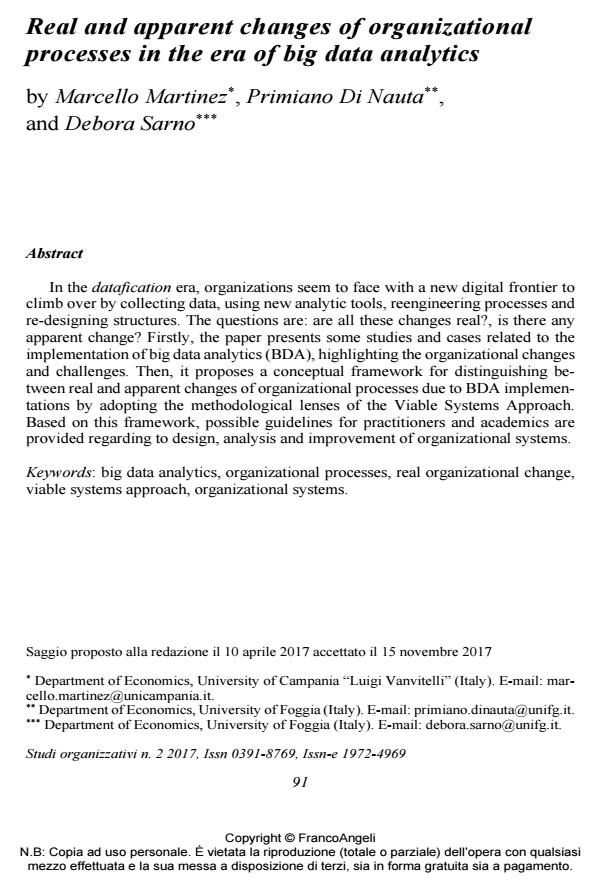Real and apparent changes of organizational processes in the era of big data analytics
Titolo Rivista STUDI ORGANIZZATIVI
Autori/Curatori Marcello Martinez, Primiano Di Nauta, Debora Sarno
Anno di pubblicazione 2018 Fascicolo 2017/2
Lingua Inglese Numero pagine 17 P. 91-107 Dimensione file 226 KB
DOI 10.3280/SO2017-002005
Il DOI è il codice a barre della proprietà intellettuale: per saperne di più
clicca qui
Qui sotto puoi vedere in anteprima la prima pagina di questo articolo.
Se questo articolo ti interessa, lo puoi acquistare (e scaricare in formato pdf) seguendo le facili indicazioni per acquistare il download credit. Acquista Download Credits per scaricare questo Articolo in formato PDF

FrancoAngeli è membro della Publishers International Linking Association, Inc (PILA)associazione indipendente e non profit per facilitare (attraverso i servizi tecnologici implementati da CrossRef.org) l’accesso degli studiosi ai contenuti digitali nelle pubblicazioni professionali e scientifiche
In the datafication era, organizations seem to face with a new digital frontier to climb over by collecting data, using new analytic tools, reengineering processes and re-designing structures. The questions are: are all these changes real?, is there any apparent change? Firstly, the paper presents some studies and cases related to the implementation of big data analytics (BDA), highlighting the organizational changes and challenges. Then, it proposes a conceptual framework for distinguishing between real and apparent changes of organizational processes due to BDA implementations by adopting the methodological lenses of the Viable Systems Approach. Based on this framework, possible guidelines for practitioners and academics are provided regarding to design, analysis and improvement of organizational systems.
Nell’era della datificazione le organizzazioni sono chiamate a confrontarsi con una nuova frontiera digitale che può essere valicata attraverso la raccolta dei dati, l’impiego di nuovi strumenti di analisi, la reingegnerizzazione dei processi e la riprogettazione delle strutture. Tra le domande aperte: i cambiamenti sono sempre reali? O ci sono anche cambiamenti apparenti nei processi organizzativi? Per rispondere a tali domande, l’articolo presenta alcuni studi e casi relativi alla implementazione di Big Data Analytics (BDA), evidenziando i cambiamenti e le sfide organizzative. Quindi, propone un quadro concettuale per distinguere tra cambiamenti reali e apparenti dei processi organizzativi dovuti alle implementazioni di BDA, adottando le lenti interpretative e metodologiche dell’Approccio Sistemico Vitale (ASV). In questa prospettiva, si offrono possibili linee guida a professionisti e studiosi relativamente alla progettazione, analisi e miglioramento dei sistemi organizzativi.
Parole chiave:Big data analytics; processi organizzativi; sistemi organizzativi.
- Complexity and Sustainability in Megaprojects Primiano Di Nauta, Cristina Simone, Francesca Iandolo, Stefano Armenia, Marco Arcuri, pp.35 (ISBN:978-3-031-30878-9)
- Towards Digital and Sustainable Organisations Paolo Canonico, Ernesto De Nito, Vincenza Esposito, Marcello Martinez, Mario Pezzillo Iacono, pp.89 (ISBN:978-3-031-52879-8)
- Significance and Challenges of Data-driven Product Generation and Retrofit Planning Melina Massmann, Maurice Meyer, Roman Dumitrescu, Sebastian von Enzberg, Maximilian Frank, Christian Koldewey, Arno Kühn, Jannik Reinhold, in Procedia CIRP /2019 pp.992
DOI: 10.1016/j.procir.2019.04.226 - Smart Education and e-Learning - Smart Pedagogy Barbara Borin, Matteo Caroli, Nunzio Casalino, Maurizio Cavallari, Nadia Di Carluccio, Primiano Di Nauta, Giuliana Pizzolo, pp.211 (ISBN:978-981-19-3111-6)
- Smart Education and e-Learning 2021 Nunzio Casalino, Stefano Armenia, Primiano Di Nauta, pp.197 (ISBN:978-981-16-2833-7)
- Rethinking Work: Pathways and Practices in Business and Society. Introduction to the Special Issue. Luigi Moschera, Mario Pezzillo Iacono, Giovanna Lo Nigro, Laura Lucia Parolin, in STUDI ORGANIZZATIVI 2/2019 pp.9
DOI: 10.3280/SO2018-002001 - Smart Education and e-Learning - Smart Pedagogy Elisa Bertocchi, Matteo Caroli, Nunzio Casalino, Stefano Falà, Marco Giovannetti, Katia Infante, Alessia Orsi, Emanuela Mariotti, Fabio Massimi, Valerio Manzo, Giuliana Pizzolo, Giovanni Paolo Sellitto, pp.269 (ISBN:978-981-19-3111-6)
Marcello Martinez, Primiano Di Nauta, Debora Sarno, Real and apparent changes of organizational processes in the era of big data analytics in "STUDI ORGANIZZATIVI " 2/2017, pp 91-107, DOI: 10.3280/SO2017-002005